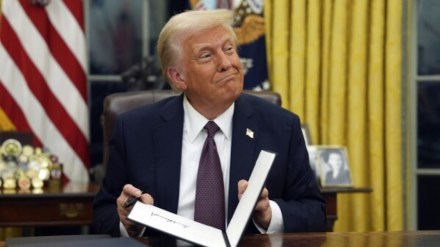At the heart of Donald Trump’s economic vision, which centres around reciprocal tariffs, lies a desire to revive American manufacturing and reclaim jobs lost to globalisation. His aim is to shield domestic industries and restore the industrial might of a bygone America. The idea is rooted in reciprocity, levelling the playing field against nations accused of unfair trade practices.
While critics have been pointing out the flaws in Trump’s logic as well as economics, economic historian Niall Ferguson has offered a critique laced in a historical framework through a series of essays which perhaps describes the President’s efforts as something like chasing a mirage. Drawing on his extensive study of empires, Ferguson has warned that Trump’s tariffs risk dismantling the very foundations of American power, plunging the nation into economic turmoil and geopolitical isolation rather than greatness.
Ferguson’s analysis, which is steeped in the history of imperial rise and fall, has cast Trump’s tariffs as a reckless assault on Pax Americana—the US-led global order that has defined the post-World War II era. In his essays, he has compared the policy to smashing a laptop with a “Minecraft hammer”, a crude tool ill-suited to the intricacies of global trade. For eight decades, the US’ empire thrived on economic interdependence, with sit being the guarantor of free markets and global stability. Ferguson has pointed out that tariffs are a “wild decolonisation”, which are unravelling the networks that sustained US hegemony. Far from reviving manufacturing, they threaten to erode the prosperity and influence that globalism, for all its faults, has delivered.
The economic consequences are already stark. JP Morgan economists have pegged global recession odds at 60%, citing tariffs’ inflationary sting. If consumers face higher prices for everything from smartphones to groceries, household budgets would obviously get eroded. This became quite apparent when Trump just exempted smartphones, computers, and other electronics from his reciprocal tariffs. The move was seen as cushioning consumers from price shocks as these items generally aren’t made in the US, and setting up domestic manufacturing would take years.
Trump’s supporters champion tariffs as a lifeline for American workers, arguing they will bring back factory jobs outsourced to cheaper shores. The vision is nothing but a 1950s America of bustling plants and middle-class prosperity, and Ferguson has perfectly debunked this nostalgia. That era’s boom, according to him, stemmed from post-war anomalies, with Europe and Asia in ruins, and the US emerging as the world’s sole industrial titan. It was not due to protectionism. Today’s economy, which is woven into global supply chains, can’t be rewound without chaos. The decline of manufacturing has more to do with automation and technological leaps than trade deficits. In this scenario, tariffs might prop up a few industries briefly, but they can’t reverse these structural shifts. Worse, they risk pricing US goods out of global markets, stifling innovation and competitiveness.
Geopolitically, reciprocal tariffs would weaken the US’ hand. Ferguson has rightly warned that shredding the liberal order would empower rivals like China, which can exploit global fractures. Trump’s quip about annexing Canada as a “51st state” shows his cavalier approach that risks turning allies into adversaries. Simply put, reciprocity, in practice, would isolate the US, and undermine its soft power which has amplified its global reach.
According to Ferguson, such a prospect would be ironic as tariffs are meant to project strength rather than revealing the US’ fragility. After all, empires thrive on interconnectedness, not insularity. For instance, Rome and Britain fell not just to external foes but to internal rot and overreach. The US’ empire, built on open trade and the dollar’s dominance, faces a similar peril. Reciprocity, therefore, far from restoring greatness, would accelerate the imperial decline.
Could tariffs ignite a broader conflict? Ferguson has flagged the trade war’s potential to escalate into a real war. History, from the Smoot-Hawley tariffs of 1930 to pre-World War II trade battles, shows how economic strife can spark geopolitical crises. With US-China ties already tense, tariffs raise the stakes for missteps, from a Taiwan Strait clash to a cyber skirmish.
The tragedy, according to Ferguson, is that Americans may not see the costs until it’s too late. This is because the populist allure of ‘America First’ blinds many to globalism’s benefits like cheap goods, abundant food, technological edge etc., all of which are tied to the trade networks that Trump seeks to upend. It can easily be concluded that Trump is betting on a mythologised past, which, according to history, can never return. As Ferguson has put it, tariffs close up the post-1930s order, ushering not a renaissance but a chaotic new world where the US’ star dims.
Trump’s defenders argue that tariffs right decades of trade injustices, giving workers a shot. But Ferguson’s rebuttal rings true—the cure outstrips the disease. Tariffs may fire up a political base, but they can’t rebuild an empire or conjure a lost era. They are a hammer swung at a delicate system, breaking more than they build. True greatness demands smarter tools like investment in technology, education, and alliances, not a retreat into economic nationalism. Ferguson is right when he says that Pax Americana’s end looms, and with it, Trump’s dream of manufacturing revival fades into a costly illusion.
